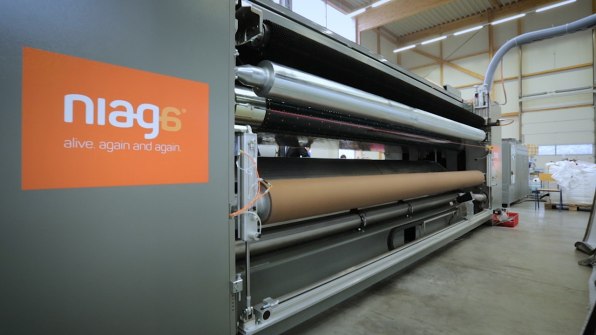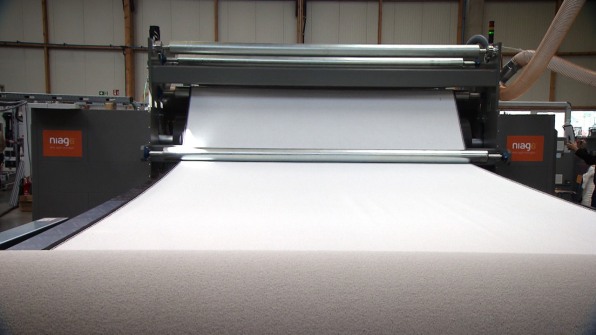How To Get Crayon Out Of Carpet
Lately, there's been a lot of momentum around devising sustainable alternatives for things that we tend to take for granted. A Swedish grocery chain is swapping out plastic fruit labels for laser marks; a brewery switched out its plastic six-pack rings for edible versions to protect ocean wildlife.
But until now, no one has made a dent in the problem of household carpeting. Second only to diapers when it comes to taking up landfill space, around 3.5 billion pounds of carpet are tossed each year in the U.S. Because carpets are made up of such a complex array of chemicals, like latex and PVC, they're next to impossible to recycle.

But Mohawk, the second-largest carpet distributor in the U.S., wanted to address this challenge for the industry. "We have a track record of innovation at Mohawk," says Tom Lape, the president of Mohawk's residential division. Mohawk partnered with the Dutch manufacturing company DSM, who along with the tech startup Niaga ("again" spelled backwards), had devised a way to manufacture fully recyclable carpets using just one material–polyester. Mohawk adapted that technology into its new line of Airo carpets, which launched in January at the International Surface Event in Las Vegas, where it won awards in product design and innovation. The carpets will hit the consumer market later this year.
The simplicity of the Airo monomaterial carpet is a far cry from the traditionally constructed carpets that proliferated throughout homes in the 1950s and '60s, leaving tack marks and scrapes on hardwood floors when ripped up and sent to landfill. "Most people don't understand, but carpet is a highly engineered material," says Bruce Petrovick, the account manager for DSM North America. "The way it's traditionally made, it contains multiple layers, and each layer contains multiple different types of materials."
In its simplest form, traditional carpet has two layers: a backing and a face fiber (the part you walk on). The face fiber is either made of nylon, polyester, or polypropylene. That's attached to a backing made of either PVC or latex; the two layers are bound together with a combination of polypropylene and calcium carbonate. The early carpet manufacturers, Petrovick says, had one goal: to figure out how to hold everything together–and chemicals were effective at doing so.
"Back then, nobody thought about recycling, or where these chemicals came from," Petrovick says. "We just made things and threw them away."

As the culture evolved to embrace recycling and sustainability, carpets remained an intractable problem. To effectively recycle them, "you have to do a lot of very costly steps," Petrovick says, including separating out and purifying all of the different materials. Consequently, recycling a traditional carpet is only feasible by hiking the overall product price, which Petrovick says consumers wouldn't stand for. "Nobody wants to eat that cost," he says.
Mohawk and DSM-Niaga looked at this issue, and decided that the industry was looking at carpet recycling all wrong. It wasn't enough to apply the same process to a faulty product; the product itself would have to be reinvented. By manipulating pure polyester to form every element of the carpet, from base to tufts, the flooring, when discarded, can be returned to the manufacturer, ground up, and repurposed as yet another carpet. The "closed loop" nature of the production cycle, Petrovick says, will also stabilize prices.
The environmental implications are significant, Petrovick says. Polyester is made from crude oils, which–like the concept of recycling itself–hadn't seemed like an issue to early manufacturers. But if the Airo technology can cut down on the amount of crude oil extracted from the ground, it could point the carpet industry on a path toward circular sustainability. "The new carpet construction process creates a more sustainable soft floor covering," Lape says; every Airo carpet, upon being discarded, can be recycled into a new carpet of a different style.
Mohawk's Airo carpets, once on the market, will act as the test run for how consumers respond to this new development. Lape hopes it will be positive: In addition to the sustainability element, the carpets don't require tack strips to be installed, meaning they can be laid directly over wood or linoleum without damaging the original flooring. "There's a lot of potential with this technology," Lape says. "At the end of its life, the Airo carpet will have an economic value that the carpet industry will want to utilize," adds Petrovick. And one that won't destroy the planet, either.
How To Get Crayon Out Of Carpet
Source: https://www.fastcompany.com/3067849/the-first-100-recyclable-carpets-are-here
Posted by: huffmanancomp.blogspot.com

0 Response to "How To Get Crayon Out Of Carpet"
Post a Comment